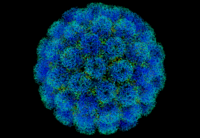
Photo from wikipedia
Viral infections attract more and more attention, especially after the emergence of novel zoonotic coronaviruses and the monkeypox virus over the last 2 decades. Research on viruses is based to… Click to show full abstract
Viral infections attract more and more attention, especially after the emergence of novel zoonotic coronaviruses and the monkeypox virus over the last 2 decades. Research on viruses is based to a great extent on mammalian cell lines that are permissive to the respective viruses. ABSTRACT Viral infections attract more and more attention, especially after the emergence of novel zoonotic coronaviruses and the monkeypox virus over the last 2 decades. Research on viruses is based to a great extent on mammalian cell lines that are permissive to the respective viruses. These cell lines are usually cultivated according to the protocols established in the 1950s to 1970s, although it is clear that classical media have a significant imprint on cell growth, phenotype, and especially metabolism. So, recently in the field of biochemistry and metabolomics novel culture media have been developed that resemble human blood plasma. As perturbations in metabolic and redox pathways during infection are considered significant factors of viral pathogenesis, these novel medium formulations should be adapted by the virology field. So far, there are only scarce data available on viral propagation efficiencies in cells cultivated in plasma-like media. But several groups have presented convincing data on the use of such media for cultivation of uninfected cells. The aim of the present review is to summarize the current state of research in the field of plasma-resembling culture media and to point out the influence of media on various cellular processes in uninfected cells that may play important roles in viral replication and pathogenesis in order to sensitize virology research to the use of such media.
Journal Title: mBio
Year Published: 2022
Link to full text (if available)
Share on Social Media: Sign Up to like & get
recommendations!